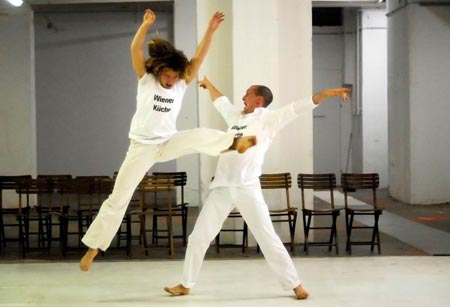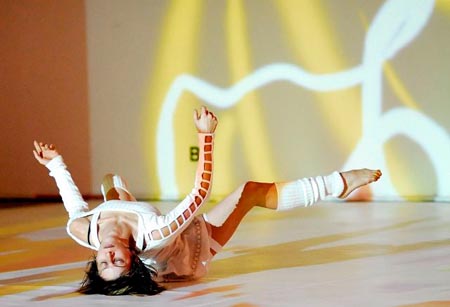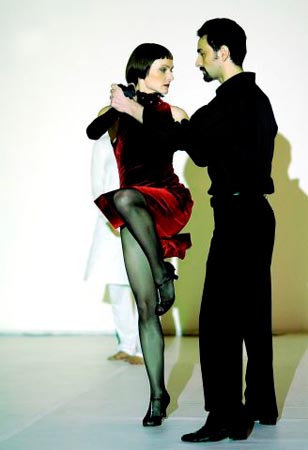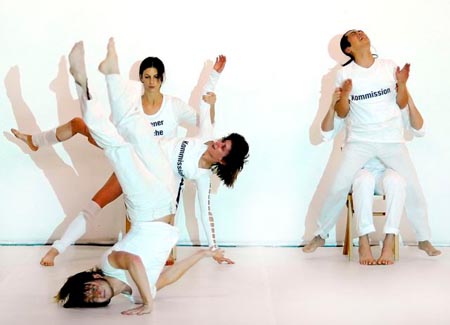The last years have not been easy ones in the dance world and Homunculus is going through the most difficult period in a creative institution’s life. For twenty-one years, they have been producing contemporary dance – indeed they are one of the originals in Austria.

Homunculus-Wiener-Kuche-1
At this point, all the crazy fire of beginning and triumphing against all odds are behind Nicolas Selimov and Manfred Aichinger. They have built an institution. They have been through three generations of dancers and are gradually going through another one. Where does one go from success?
To their surprise, it doesn’t get easier. Selimov’s essay in the program states:
The big challenge for we dance creators is to make certain that contemporary dance maintains its place in the spectrum of performing arts!
I am as astonished as Selimov at the long winter of dance throughout the world, with slowly dwindling audiences and mediocre institutional support. Like Selimov, after discovering dance for myself twenty years ago, I only expected dance to grow and grow in popularity.
The one real long term success story in contemporary dance of which I know is Anna-Teresa de Keersmaeker’s Rosas. She continues to produce varied (but stylistically unified) work which fills theatres, year after year. Keersmaeker is brutal in her choice of performers. One fits a mould and one hits one’s marks every time if one wants to be a Rosas dancer. Keersmaeker has built a school and from the school both takes new dancers. She has managed to develop talented new choreographers from internal ranks like Salva Sanchis. Yet still Keersmaeker herself remains the undisputed center of this miraculous company. What will happen to Rosas in her absence?
Homunculus faces some of the same challenges. They have done many good things. Selimov and Aichinger have given a chance to some of their dancers (Karin Steinbrugger, Martina Haager, Andrea Stodder) to choreograph on the company – so far with mixed success – no clear replacement for themselves has emerged. They had the very good idea of grooming Staatsoper dancer Nicky Adler, as an alternative main stage choreographer for the company – until the new Staatsoper direction refused to allow Adler any free rehearsal time in the season for work outside the Staatsoper Ballet. A Staatsoper dancer is very well paid and eligible for a pension on retirement so losing one’s place there for freelance choreography would not be a wise move.
Last winter Homunculus was scheduled as the opening show of 2006 at Tanzquartier with a promising program of live basketball played in Hall G of Museumsquartier with nets and a court while the dance piece went on. Unfortunately, for reasons unknown to this reviewer, that show was cancelled. That particular TQW season was much the worse for the absence of Homunculus. The last year has not been easy for Homunculus.
In many ways, Adler was much the best choice as a new main stage choreographer for Homunculus. His work is intellectual and inventive and very much in the Homunculus company tradition. For Adler, the fit is very good as well. A Vienna native, Adler grasps the Homunculus idiom intuitively. Rarely does Adler need the grace and the technical perfection of Staatsoper dancers – but in every show he asks for something strange and different.
Adler’s rien ne va plus garnerred several prizes for Homunculus and very good critical notices.
A second recent experiment with an outside choreographer Bernd Bienert was less successful. His show Alzburg: Eutopa at Semper Depot garnered little critical praise while privately the Homunculus dancers were furious to see their talents wasted, complaining both about the action which involved a lot of standing around and lying on the floor and Bienter’s imperious manner (quite frankly standard practice in the ballet rehearsal rooms) and his refusal or inability to take advantage of their own invention and fantasy. The same Bernd Bienert works very well with classically trained dancers. His Unruhiges Wohnen at ImPulsTanz two years ago was an absorbing if depressing tour-de-force of modern dance. I have reservations about the score and the dramaturgy based on Elfried Jelinek’s story about the abuse of a little girl – but Bienert never ran out of movement, nor was his neo-classical choreography ever self-conscious or stilted.
In the meantime, that leaves Homunculus without a new choreographer. But necessity remains the mother of invention: Nicolas Selimov who for the last seven years has been more intendant than creator stepped back in with company founder Manfred Aichinger for this year’s main autumn piece Wiener Küche. Selimov’s Oh it’s Vienna is the best piece of work I’ve seen from Homunculus – and while I only saw it in a rehearsal performance, I believe time will show Oh it’s Vienna to be one of the lasting works of contemporary Austrian dance. But Oh it’s Vienna is not so much dance as cabaret.
And so is it with Wiener Küche.
The show is held in an empty warehouse space on Neustiftgasse. How or where homunculus found such desolate space empty right in the middle of Vienna is something of a miracle, but the setting is superb. An artificial foyer is created by wrapping orange tape around the columns. The audience is required to wait as a group in the lobby which is lit by soft and warm lighting. As usual, Homunculus set and light design was the work of Silvia Auer.
At eight o’clock sharp a team of black shirted security guards come to the foyer check the audience’s tickets and let them into the theatre one by one. This is just the first of four checkpoints on a winding path to the actual main stage space. Our bags and persons are checked later. The dancers are poker-faced and severe throughout the process, showing no hint of humanity.
In a final humiliation the audience members are gathered into a tight space as a group where the tallest of the male dancers in a headset (Julian Timmings) selects people to enter, one by one. Yes, it’s a nightclub queue. Consciously we know that eventually we will all be let in but the feeling of absurd helplessness of waiting on some idiot twenty year old to select or not select us remains.
Once inside the tables are turned, just as in a nightclub. We are served drinks in our seats for one euro each by a lovely waitress (Natalie Trs).
Throughout there is a woman’s voice speaking softly but severely to the audience as a group and a collective. What we should and should not do. Just as in an airport or train station. The voice is quite incredible, like the official voice of modern authority, from airports to television. Curiously the voice is that of former Homunculus dancer Susi Wisiak.
If you don’t do what the voice of authority says in Austria, the consequences can be severe. Austrian organisational systems works very well and are not to be lightly bucked. We all know this here and are appropriately intimidated.
Once the audience is settled, the voice starts addresses itself more often to the performers. There is a long speech at the beginning about what the show will be about – “no dance, whether you paid your place as a spectator for the performance or not”.
There was a great deal of t-shirt work in the show. For the main show all the shirts were white. The first set of shirts included work designations like “Contract Worker”, “Part time worker”, “Independent Contractor”, “Full time worker”. These shirts made an overtly political point about the precariousness of modern existence. There are very few sure jobs in this day and age. But the relationship of economic structure to the roles is not quite clear. The labelled characters feel like something of a regression to Medieval allegorical theatre.

Julian-Timmings-Amadeus-Berauer-2
Through most of the evening a group of people in business clothes sitting behind a table was projected on the ceiling – a hypothetical committee of those above. In addition to the voice and committee projection, the artist Eva Flatscher practiced light painting with a Wacom tablet which was projected behind most of the dance sequences. Personally I found this light painting too digital but I am no great amateur of electronic art.
At the beginning of the show, each of the Homunculus dancers had to do a dance for the others, for the so-called committee. They were given performance notes and sometimes numerical evaluation. The performances were not especially interesting – Amadeus Berauer began the festivities by puking on the floor, the lovely Karin Steinbrugger shrieked wildly, looking like a Nicole Kidman gone mad. Natalie Trs has the most astonishing section of all, wherein she strips down to nothing and sings Janis Joplin ditties.

Natalie-Trs
All of this sounds like more fun than it was. But frankly I missed the underlying gag here, until a fellow spectator pointed it out to me. Much of Wiener Küche is based on reality tv. I’ve seen people I know well sit at home and watch other people eat buckets of raw worms for a $100 prize on North American wide television. One does of reality tv was enough for me but most people are fascinated by it. Astonishingly, those who fail to eat the worms or lie down with rats or whatever absurd challenge was put in front of them face verbal abuse from the moderator for their lack of courage. What could persuade someone to put up with that and not dip the moderator’s head into the bucket, I cannot tell you. Apparently the Nicolas Selimov and Manfred Aichinger wonder about this too.

Natalie-Trs-Kun-Chen-Shih-Julian-Timmings-Amadeus-Berauer
At some point the reality tv panel takes a back seat to the Homunculus dancers cooking dinner. To follow the television metaphor, we move from reality tv to cooking show. I wondered how earnest the cooking was. The cooking was in deadly seriousness. Every night after the show, that is the artists’ dinner.
The pun on Wiener Küche and the idea of a night at home with Homunculus entertaining one another with skits while they cook is entirely engaging. It is a great idea for a film and in fact is most of the framework on which Denys Arcand’s masterwork Le déclin de l’Empire Américain is hung.
In addition to the cooking and the skits, the show was broken up by about four tangos from Betka Fislova and Germano Milite. While they danced competently enough, there was no real passion in their steps. This was probably intentional – ballroom dancing shows are currently very popular on Austrian television – and the dancing can be very desultory and proforma there as well. Still it added numerous extended sections without much passion. I know television is boring, fake and lifeless. I don’t need to come to the theatre to hear about it.

Betak-Fislova-Tango
It’s a pity not to see more dancing from Karin Steinbrugger, Andrea Stotter, Martina Haager and Eva Maria-Kraft who are all wonderful movers. Eva Maria-Kraft’s dance sequence at the end was deliberately programmed for constant interruption by the other dancers. But Wiener Küche is unabashedly cabaret and not dance.
Somehow, in the end, the parts were greater than the sum of the whole. After about 90 minutes the pace started to drag very badly. Curiously enough just after this the female voice came back with a ten minute countdown.
What is especially difficult is that the first half hour was so unexpected and so strong – who expects to be frisked for weapons and have one’s ticket checked three times on the way in to a modern dance performance in Vienna?
The negation is much stronger than the statement. I don’t know what Aichinger and Selimov are proposing as an alternate world. Does an alternate world still exist in the din of senseless media and information overload?
But that is material for another show.
Overall Wiener Küche is recommended. As much of Wiener Küche is partially improvised, the overall tone of the performance can vary significantly. My friends who had seen it on an another evening and come back for a second showing thought that Wiener Küche has been much stronger the first time they’d seen it.

